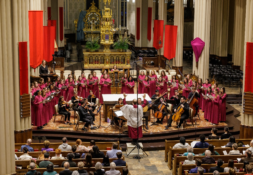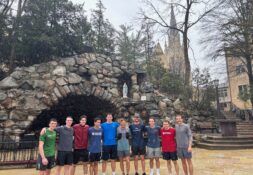Avante-garde sculptures distract from Notre Dame’s beauty
The Raclin Murphy Museum of Art opened to the public on December 1. The new museum, designed by Robert A. M. Stern Architects (RAMSA), has replaced the Snite Museum of Art as home to Notre Dame’s art collection. The 40-year-old Snite Museum, relatively small for an institution such as Notre Dame, was dwarfed by the ever-expanding campus.
The completion of Raclin Murphy gives the Notre Dame community cause to reflect on the purpose of art, and its significance in our lives. Joseph Becherer, director and curator of the new museum, told Notre Dame Stories, “The arts are one of the most profound elements of human condition, and one of the greatest gifts we can share with one another.” He added, “They can offer insight, understanding, joy, even healing.”
Many Notre Dame students do not have the time, however, to frequent a museum like Raclin Murphy. Computer science third year Nolan Kyhl notes that, if he experiences art during the typical day, it is often “on [his] way to class.” Kyhl, like the majority of Notre Dame students, engage with art on campus primarily through the architecture and sculptures that define the campus environment. The Notre Dame classics such as “First-down Moses,” the “Holy Hand-off,” and “Fair-catch Corby” are well-known and loved by students, but alongside the busier walkways of campus, recent years have seen the installation of several new abstract, avant-garde statues.
These modern attempts to decorate campus, found near main academic buildings and around South and DeBart Quads, are a familiar yet uninspiring sight to students on campus. Just in front of Riley Hall, there is what looks like a neon-green I-beam with various embellishments, bolted into the ground. To its left, another large metal sculpture, this one a sort of rusty brown, looms over the sidewalk. At its base, the inscription “SHORE 99” names the artist and year of completion. The sculpture appears, at one point, to have been occupied by a rather messy bird.
At the edge of South Quad, perched on a small, four-legged pedestal, stands what is called by some students the “screaming torso.” The statue’s black face, twisted in a sort of howl, contrasts with the narrow, white chest and belly beneath it.
Moving now to DeBartolo Quad. Like a pair of confused sentries, a pair of abstractions stand on either side of the entrance to McKenna Hall. The first is named “Koinonia” (a transliteration of the Greek word for friendship) by Alison Helm. It is a turquoise sculpture of metal and glass, consisting of a series of ovals standing on end. The second is “Kanzan”—named for a species of flowering cherry tree—by Michael Todd: it is a brown ring with a few pieces of metal at its base. Moving further down the quad, there are what appear to be two large pieces of stone or wood, balanced on top of a pair of giant wishbones.
Has Notre Dame added something valuable to her students’ experience by erecting these sculptures around campus? Has she succeeded, as Becherer claimed, in offering “insight, understanding, joy, even healing,” or, as the university website put it, “reminding us of the uniqueness of the human spirit?” The students themselves seem to think that she has not.
When asked about the pieces described above, Kyhl told the Rover, “Those examples have always struck me as not trying to make any statement. They seem neutral and vague so I’m left wondering why someone decided to make it that way.”
Annamarie Todd, a junior studying chemical engineering, said, “I have to say I’ve always thought the bust statue outside of O’Shag was a little creepy. I don’t know why, but it always made me think of someone dying from lung cancer … The other ones I can’t say much about. Maybe it’s just me but they’re a little too abstract for my taste.”
Luke Shah, a first year finance student, was not as gracious: “Scattering the garbage in grandma’s attic across South Quad doesn’t do our beautiful campus any favors.”
There is a note of contradiction in the abstract ugliness of these sculptures. They feel out of place amid pieces like the Word of Life mural, or the stained glass of O’Shaughnessy, or the statue of Our Lady atop the dome. Notre Dame students are moved not by novelty and abstraction, but by beauty and significance. Todd, for example, noted her appreciation for the scene of the woman at the well outside of O’Shaughnessy. “I just think it’s a really beautiful piece of art that tells a story in a really cool way.”
When asked what kinds of pieces he would like to see around campus, Kyhl said, “If I were to add another piece of art to campus I would choose … something that would elevate people to think more highly of education. Maybe that could be a beautiful scene of a professor and a student, or a student discovering beauty in their work.”
What is the purpose of art at Notre Dame? Nathan Desautels, a junior studying philosophy and theology, told the Rover: “Art, especially at a Catholic institution, ought to respond to the dynamic impulses of the Holy Spirit. Would few, if any, say that these works respond to the dynamic impulses of the Holy Spirit?”
The choice to litter the campus of Our Lady’s University with abstract sculptures that can only be fully appreciated by those educated in the fine arts is ultimately grounded in an elitist mentality that cares more for the expert than for the common man, and values the avant-garde over the beautiful. These pieces take away from, rather than adding to, the Notre Dame experience.
Jack Thornton is a PhilThe junior. He looks forward to enjoying a lucrative career as a theologian, the only position that will never be replaced by AI. Contact him at jthorn22@nd.edu.
Photo Credits: The Irish Rover
Subscribe to the Irish Rover here.
Donate to the Irish Rover here.





